A Day in the Life of an Extension Educator

My name is Cindy. I am an Extension Educator working for Nebraska Extension. I am a Registered Dietitian, avid gardener and mother of three busy children. Recently, I got the privilege to participate in a SARE tour. SARE stands for the Sustainable Agriculture Research and Education program. Funded by the USDA, the national SARE program supports and promotes sustainable farming and ranching. They offer competitive grants and educational opportunities for producers, scientists, educators, institutions, organizations and others exploring sustainable agriculture. In Nebraska, SARE focuses on local food producers, beginning farmers, sustainable ag issues, and other ag topics. As an RD, I am interested in the total farm to fork continuum. If you eat, you are involved in agriculture!
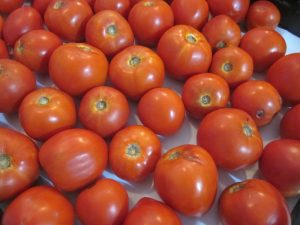

One given in agriculture is that all producers have a place at the table that feeds the world. Not one farmer, one organic farm, nor one rancher can feed the worlds exploding population. But as a whole working together, it can be done better, faster and with less than in the past. That is what this tour was about. Different producers raising crops in their unique way. He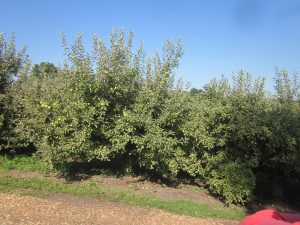 re is how my day rolled out:
re is how my day rolled out:
The first producer we visited was Kimmel Orchard and Kimmel Education and Research Center in Nebraska City. Richard and Laurine Kimmel believed in the land and in sharing what the land produced with their neighbors. Since 1925, apples and cherries, among other dozens of fruits and vegetables have been produced on their land. The Orchard is dedicated to agricultural education research and historic preservation. It’s a destination for fresh, locally-grown produce and other home-grown Nebraska products.
They are in the process of replacing old apple trees that have stopped producing as much with new ones. They are planting and raising tall spindle apple trees in their orchard. They are able to grow more trees in less space, and have twice the production of apples from a regular apple tree. They are short (nine feet) and are easier to pick, so less man-power is needed. They produce more apples than a regular tree in half the time due to the trees density. They expect over 30,000 bushels of apples in September.
They have so many other types of produce to purchase. Here is a little secret–if you pick cherries there–they will pit them for you! The orchard was really something to see! 
They are growing the sweetest peaches and grapes. The grapes are sent off to be made into many varieties of wine, and sent back to the orchard for sale. They also have 40 acres of U-Pick crops–ranging from apples to zucchini, with pumpkins being extremely popular in the fall! Another well know secret is that people will line up to taste their apple donuts! They are incredible! The hay rack ride around the entire farm is quite educational! I recommend it!
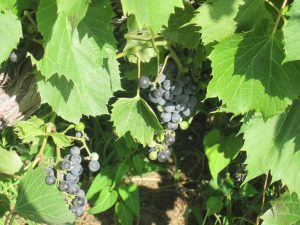
The next producer we visited was the Garden of Ellen. Ellen Shank and her husband Jim have both retired and undertook a second career of raising and marketing produce from high tunnels and the garden on their farm in 2011. The Shanks market their produce at area farmers markets and from their farm. They have figured out that they can bring produce to markets sooner that bigger producers by using their high tunnels. That gives them an edge in the beginning of the growing season. 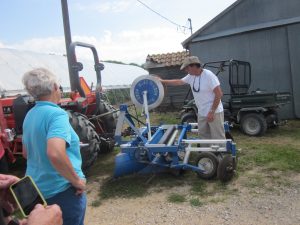
Ellen is a retired nurse, and her sanitation standards on their farm are impressive. For a small farm, they function as efficiently as someone with thousands of acres! With just the two of them, and this summer a high school student, they are able to produce an incredible amount of food in a small area. 
They use ingenuity to make things work. For example, they wanted to plant onions early, and have them grow faster and weed less. So they decided to plant them under a tarp to reduce weeds and heat the soil so they could plant earlier. But how do you get the onions under the tarp? The machine above disks the dirt into hills and lays down a sheet of black tarp as it goes. They developed a barrel system with “pokers” on it. They roll it over the tarp–and voila! Holes to plant onions! They plant their cantaloupe on tunnel-shaped trellises to deter salmonella. Their produce washing system is something to see also! I really enjoyed tasting fresh berries from their bushes!
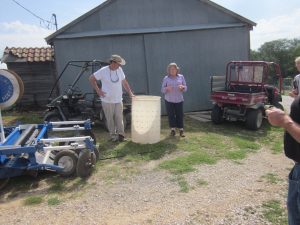

Union Orchard was our next stop. It was formerly owned by the University of Nebraska since 1917, but now is owned by the Wostrel (2011) family. The Wostrel’s and orchard manager Vaughn Hammond are developing the orchard and transforming it into a destination for families to come visit year round. As most of the existing 6500 fruit trees are over 50 years old, they will be replanted. Thirty acres will be replanted in apples, peaches and pears. The remainder of the property will be planted in pumpkins, heirloom squash, asparagus, strawberries, raspberries, blackberries, blueberries and elderberries. 
They are replanting and growing the orchard to include more varieties of apples and grapes. Some of the crop is sold fresh in their store, and others are made into value-added products like pies, donuts, jams, jellies and wine. We dined in their pavilion for lunch. It included lots of fresh produce!
The ride around the orchard was very impressive. They are producing a great deal of produce with a very SMALL amount of workers. They worker smarter, not harder.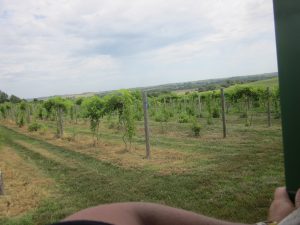
The next producer we toured was the Nebraska Hop Yard. If you have never seen hops grow–you need to check this place out! Hops demand is on the rise with the increase of craft brewers growing at a rate of 15% in 2015, totaling 4,269 breweries–the most EVER! (Brewers Association, March 2016).

Using funds from Nebraska Department of Economic Development and their own private funds, Bruce and Annette Wiles have transformed the former Plattsmouth Country Club into an agribusiness where they grow hops.

The Wileses, who founded and own Midwest Hop Producers, Nebraska Hop Yards and Midwest Hop Yard Supplies, are focusing on growing and marketing the hops. They did extensive research, and visited many other hop farms to make sure what they produce works and can be passed down thru generations. The really did their homework–as the production is doing well! The Nebraska Department of Economic Development in August said the Wileses are investing more than $3.5 million in site improvements, construction of the hops harvesting, drying and pelletizing operation and other buildings and equipment. The project is expected to create as many as 20 jobs. Phase I of the development is complete at a cost of around $2 million. The former clubhouse had been remodeled and 15 acres of hops has been planted. Harvesting and irrigation equipment has been purchased and two greenhouses have been built.

They are growing 27 different varieties of hops. This is considered Nebraska’s newest value added ag enterprise! Hops are grown on strands of rope, and twirl counter-clockwise to the top. One to three or four plants can share a rope. Hops do not produce much, if anything the first year, but produce more the second, and by the third year are producing at maximum capacity. With the growth of the craft beer industry, the supply of hops is not keeping up with the demand. The demand is opening up the market to small farms in Nebraska and the Midwest. It is amazing that you can rub the hops between your hands and actually smell the type of beer they may be used in!

Our final stop for the day was the Lakehouse Farm and Prairie Plate Restaurant near Waverly. It is owned and run by Jerry and Renee Cornett. They are both retired Navy helicopter pilots. Jerry manages the farm side, and Renee, who has a culinary degree, is the chef and manager for the restaurant.

Prairie Plate Restaurant is a farm-to-table restaurant located in a rural lakefront setting where guests will enjoy a seasonal menu based on products from the co-located Lakehouse Farm and regional providers. Outstanding regional and seasonal ingredients provide the foundation for their menu. Their mantra is “it will never be fresher or better than in the place it’s grown and raised”. They use local, pasture-raised Animal Welfare Approved meats and source egg, dairy, and grain products from local artisan producers as well. Over 85% of the vegetables on the menu come from their co-located certified organic farm. All other produce is sourced from other local farms. 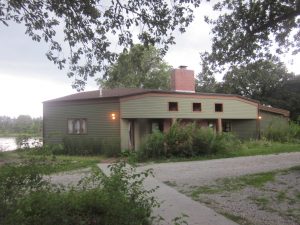
Besides using all the produce in the restaurant, they also provide items for their CSA and a farmers market in Lincoln. If something is in season today–you will see it on their menu tonight. It is really that fresh! They have a few high tunnels that allow them to raise produce longer than the average producer. Fresh leafy greens are one of those items they can still use fresh in the cold months. They have also figured out a way to keep their produce cold until they use it or sell it, with a self constructed cooler. It really is quite something to see!
The Cornett’s have a passion for what they do, and it shows in their farm and their food. We finished our tour with a “snack” in their dining room. It was WONDERFUL! Bruschetta with garlic rubbed crostini and a wheat berry salad, with mint water. After traipsing around in the heat all day, it was a perfect way to end our tour. We were able to tour their kitchen and see how they are able to use it for double duty. It is a restaurant kitchen that provides meals for hungry diners, and it also functions as a sanitary place to clean produce to sell. The restaurant has a full wall of widows facing their lake, and it is definitely a destination place to have dinner. 

I was quite excited to see so many ways producers are meeting the needs a growing population, one person at a time. You should check out local producers in your area–they all have a story, and are passionate about the importance of what they do for a living!
